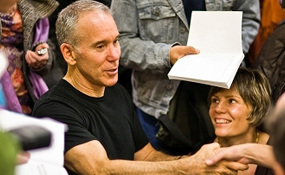by Dan Millman: “United we stand, divided we fall. Many hands make light work. No one is smarter than all of us”  The principle has been stated many ways, but each statement expresses the same sentiment: Working together, we can accomplish tasks that would be difficult or impossible without cooperative effort-for example, building a skyscraper or staging a play.
The principle has been stated many ways, but each statement expresses the same sentiment: Working together, we can accomplish tasks that would be difficult or impossible without cooperative effort-for example, building a skyscraper or staging a play.
“Once we establish the limits and boundaries of our responsibility, we can take full charge of that which is our duty and let go of that which is not; in doing so, we find more enjoyment supporting others, as we create more harmonious cooperative relationships.For peace of mind, we need to resign as general manager of the universe.” –Larry Eisenberg
In every endeavor in which people work together at different levels of responsibility, some people may have more visibility, but they are supported by other people without whom their efforts would be unproductive. What would the rock star do without the sound technicians? Could the corporate president or head of the board run a company without efficient secretaries? When achievers rise in politics or industry, they are supported by others who form the foundation of their enterprise.
Families, corporations, or empires rise or fall based upon the quality and level of cooperation and responsibility within their boundaries. At the individual level, our own effective functioning as human beings depends in large part on our internal states of cooperation.
Before we can help others, we have to help ourselves-to put our internal house in order-and reconcile our conflicting subpersonalities: those identities, beliefs, values, and ideas that seem to oppose one another or sit on different sides of the fence. We may even need to facilitate active cooperation between the right and left hemispheres of our brain. Before we can find harmony, we have to notice what is out of harmony-the either/or, yes/no, I should/I shouldn’t dichotomies that result in confusion since every decision involves pros and cons. A variety of approaches exist to harmonizing our “parts,’ such as subpersonality work, Voice Dialogue, Neurolinguistic Programming, alchemical hypnotherapy, and other educational methods that help integrate both hemispheres of the brain.
In our relationships with ourselves, with other people, and with our own circumstances, we need to discover our point of balance, define and delineate the limits and boundaries of our appropriate level of responsibility, and recognize that our values, needs, and priorities may rightfully be very different from our parents’ siblings’ spouse’s, or other people’s.
Those of us who feel a strong drive to support, serve, and assist others can, in our need to give, sometimes overcooperate to an extent that debilitates both us and those we serve. In extreme cases, this tendency to overhelp degenerates into codependency, where we lose ourselves in obsessive focus on other people’s lives, pouring out without receiving in return. Codependents assume responsibility for other people’s lives far beyond the normal duties of parents or friends or employees. They base their value, self-worth, and even their identities on their ability to help other people, always (rather than sometimes) focusing on others’ needs before their own, a form of playing doormat or even slave.
The overcooperation that lies at the core of codependency involves a distorted or exaggerated sense of responsibility, leading us to try to “fix” others’ mistakes rather than allowing them to learn from the consequences of their own behaviors.
If we overcooperate with other people, they will rarely complain about it. We rarely hear others say, “You’re just too easygoing!” However, we will soon discover that when the pendulum of our psyche swings too much into overcooperation, eventually it swings back the other way, into undercooperation. This shift may take a few days, weeks, months, or even years, but sooner or later, it happens.
In the case of undercooperation, we either go into complete while withdrawing emotionally. Unless corrected, this can lead to the death of a relationship.
Happily, relationships suffering from traumatic or chronic cooperation issues can be saved or, in some cases, resurrected. The “miracle” involves finding a new balance between giving and receiving-establishing a mutually supportive relationship. Open communication can lead to a more equal sharing of responsibility, lifting the psychological burden from the shoulders of those with codependent tendencies. The major responsibility for establishing a new balance, however, rests with those who have such tendencies.
Responsibility in itself seems a desirable attribute, but those of us who feel overly responsible-who feel compelled to overhelp-need to shift our attitude and actions and find our balance point in order to achieve a state of true cooperation and balanced responsibility.
The most powerful form of cooperation and support may sometimes mean encouraging and empowering other people to do things for themselves. The best assistance often includes making the right demands.
The Law of Responsibility serves as an essential reminder of the value and ultimate necessity of finding, respecting, and working within our own comfort zone. While we’re all here to stretch our comfort zone, we’re not here to ignore it. This law reminds us to respect our intemal values and to find our own point of balance.
Let’s take the example of Rosalyn and Tanya, each mother of two young children. Both Rosalyn and Tanya were formerly advertising executives who commuted daily to work in San Francisco. Rosalyn decided to stay home with her children, putting her downtown career on hold; Tanya, on the other hand, continued working downtown and found a good nanny to take care of her children while she was at work. Rosalyn and Tanya made different choices. The issue here is that neither woman chose what she most deeply wanted to do; instead, each chose what she felt she was “supposed to do”
Rosalyn felt frustrated at home, but she believed that she had to remain with her children all day to be a “good mother” Tanya hated leaving her children every day, but she wanted to be a “modem woman” with “equal opportunities,’ not “tied to the home” the way she felt her own mother had been.
Both women were, in a sense, overcooperating with someone else’s values and ideas of what they “should” be or do rather than listening to their own needs. Happily, each has now found a balance that works well for her. Tanya has found a way to work at home so that she can see her children more, and Rosalyn is back in the office, working part-time and loving it, and she better appreciates the time she has with her children because her other needs are being met.
In applying the Law of Responsibility, we support others, but we also accept support; we find a balance between the two. We find the difference between what we think we “should” do or be and what our heart really desires. We do what we can feel good about inside; if we don’t feel good inside, we state our feelings and reach a compromise: “I’ll do this much, but you’ll have to do the rest” That’s the heart of responsibility and the soul of cooperation.
The following exercises can help you achieve alignment with the Law of Responsibility through direct experience and application.
Experiencing Responsibility
Before finding a balanced sense of responsibility to self and others and achieving true cooperation in the world, we need to experience it within ourselves. This visualization exercise works with the subconscious to harmonize conflicting parts. With a little practice, it takes only a minute or two. It also provides valuable practice in conflict resolution and can serve as a template for working out balanced, mutually beneficial agreements with others.
1. Imagine a safe and special place anywhere in the world or the universe. It could be a granite plateau high in the mountains, a hidden glen, or a quiet meadow-your own private inner space. 2. Create the image of a table with two chairs, one on each side.
3. Invite two opposing parts of yourself to reveal themselves, one at a time, and to sit down, facing each other, across the table. You might invite one part that represents your mind and one part that represents your body, a part you like and a part you dislike, a part from the past and a part from the future, or a judging part and a forgiving part. Whenever you have mixed feelings or feel torn in two directions, you can access two parts to represent these feelings.
4. Ask each part what positive outcome or intention it has for you. Even if one part seems negative, trust that every aspect of your subconscious exists for a reason and is doing its best to serve the whole.
5. As each part appears in your mind’s eye, note what it looks like, how it moves and sits down, and how it behaves. When both are seated, note how they relate to each other.
6. Internally ask both parts to express themselves until they find a place of cooperation, rapport, and communication so that in the future they can work together.
7. When you feel complete, thank them, say farewell, and leave them to enjoy their meeting.
Application of the Law of Responsibility
1. Either write or recite to yourself a short list of things you would be willing to do if someone asked you and a short list of things you would not be willing to do. Where do you draw the line and why?
2. Write or recite to yourself a list of things that you feel comfortable doing and things that you don’t feel comfortable doing for others at home or work.
· How many of these tasks do you continue to do, and why?
· Do you do things for people, such as your children, spouse, or relatives, and then complain?
· Do you feel responsible for other adults’ mistakes or lives?
3. Consider briefly the areas of your life where you might be feeling overly responsible and where you tend to overhelp or else withdraw in resentment. If you feel exploited or unappreciated- like a martyr or a doormat-what might you do in your life to find a better balance?









































